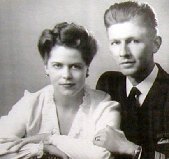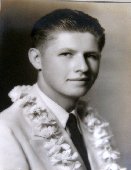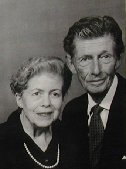The Hatch Way
Editor’s Note: Do not get this brand of the flu that I am enjoying no end. I even got my shot on time back in October, and it didn’t matter. This strain is virulent, disgusting and really cuts into your social life.
– Vic
The Hatch Way

(Then-LT Bill Hatch. Photo Hatch family).
It was a curious coincidence. I was going to a funeral on my birthday. CAPT William Hatch had passed away on the on the 6th of June, the sixty-second anniversary of the landings at Normandy. When he died, he was the oldest living naval intelligence officer. Now it was our pal Mac Showers, and as our friendship deepened, I offered to drive him to the ceremony out in distance Leesburg.
I did not know him personally, but I edit a journal that is devoted to the study of the profession, and I felt an obligation to provide a presence from the organization. People of his vintage are getting scarce, and it is imperative to honor them before their families and keep the memories alive while we can.
The memorial service was held at Saint James Episcopal Church out in Leesburg. Bill Hatch and his lovely wife Nancy had purchased a working dairy farm out in Loudoun County back in 1950, when the memories of the Civil War were still alive, and Leesburg was remembered as the place of the great victory against the invading Yankees at Balls Bluff, just outside town.
There is a postage-stamp national cemetery there, home to the dead of that day long ago. It is now in the middle of a suburban subdivision, and the last time I was there, the Confederate battle flag was flying from a staff in the middle of it.
The battlefield would have been pretty much the same as it was when the Yankees were hurled back into the river when the Hatch’s and their five children moved in. It was a different Virginia then.
Mac and I navigated out the Dulles Access Road, and then the Greenway Toll road. We made excellent time from Arlington, and I wondered how Bill Hatch had done it. He did not retire until 1973, and there were years of the commute from the farm down to the Pentagon on two lane blacktop roads.
Mac laughed and began to tell me some commuting stories that made my toes curl. “We used to drive across Constitution Ave to get to Ft. Mead and our jobs at NFOIO. Bill would come in from Leesburg, we would jump in one car in Arlington and race for The Fort.”
Living in Loudoun was a statement in those days. Admiral “Shap” Shapiro worked directly for Bill in Washington when he was the Deputy Director of Naval Intelligence, and he said once that try as he might, he was never able to get to work ahead of him, and that was after he had milked the cows, done the chores and driven down to the Pentagon.
It was a pleasant day for a drive. High thin clouds, blue above, a little cool for a day in early June. I took Business Route 15 into the historic district of the city. Leesburg is the County Seat, and the courthouse and downtown buildings square off across narrow streets. They were filling up with weekend tourists as I passed through. I had excellent directions from the Church website, and pulled up in front with plenty of time to spare.
St. James’ Episcopal Church is a massive structure of stone hewn from the bedrock of the county. It has expanded over the years, with the present main church laid down in 1895. Shelburne Parish traces its history back much further, to colonial times, when it was carved out of the western portion of the Parish of Cameron in 1769, when the Church of England was still the established state religion. The first church in Loudoun County was built in 1733, and called the “Chapel of Ease for the comfort of the people above the Goose Creek.”
Before 1769, the Chapel of Ease was served by visiting ministers. The first resident rector was the Rev. Dr. David Griffith, a distinguished churchman, who served from 1771 to the year of the declaration of Independence in 1776. His service lasted past the surrender of Cornwallis at Yorktown, and the disestablishment of the Anglican Church. Three years after independence, in 1786, he was the first man elected bishop in America.
Unfortunately, funds for his travel to England could not be procured, and he died, unconfirmed.
Captain Hatch had a lot of friends. Mac Showers is a former Deputy Director of the Defense Intelligence Agency who served with Chester Nimitz in the war in the Pacific. He made an eloquent statement the day after the news began to circulate of Bill’s passing. That was basically what I knew about him, except for the excerpt from an ancient Blue Book that he was the senior living intelligence officer.
Now it is Mac.
Mac said that he had been in declining health for some time, but remained at the farm south of Leesburg. His eldest daughter had informed him that Bill me died peacefully with his children in attendance.
I walked up the street to the formal entrance to the church. Bob Juengling was standing on the porch, looking up and down the street to see who was approaching for the service. Like me, he was there to honor the memory and service, and to sit in the back of the church. Bob is a little older than me, and he retired with 33 years service. He would have stayed longer, too, if they had let him.
We chatted on the porch, making ourselves useful by opening the door for the family and friends arriving, including Admiral John Marocchi and his wife. John had been terribly injured in an explosion the War, and still bore the scars. They seemed a bit frail, but still independent. John is now the second oldest surviving officer, and one of the last with World War Two service.
We like to be useful. We greeted people and gave directions and information from the porch, and held the door for folks with canes. A Navy Captain in dress blues strode briskly up to the steps. I did not recognize him, and when I introduced myself, he said he was a local reservist, and had seen the notice in the paper. He said it was only appropriate that someone was there, in uniform. It was the least he could do.

(Nancy and Bill Hatch at the end of WW II)
Bob told me what he remembered about Bill, between opening the door for people, and saying “Good morning!” He had been an icon in our community. A gentleman, and a family man who with his lovely wife Nancy set a standard for Naval Intelligence couples to follow. There was a generation of “Hatch-trained man,” and Admiral Shapiro considered himself one of them. His first assignment under him was in the Soviet (Y) Branch in the office of Naval Intelligence, which Bill headed, and in 1968 he was his deputy at the US Navy Headquarters in London on North Audley Street.
I will always remember that building fondly, and the pubs around it. It was where Ike Eisenhower had his headquarters before he crossed the Channel in 1944.
In London, Bill had been the intelligence officer for Admiral John Sidney McCain, the father of Senator John McCain. The Admiral became Commander in Chief of the Pacific Fleet after London, and it was then that his son was shot down and captured by the North Vietnamese. Some say the only reason that John got enough medical treatment to live was the fact that his father was the Admiral in command of the naval forces off the coast.
We passed the minutes with small-talk as the time for the service grew closer. The breeze was fresh, and smelled of rolling fields and rich grass. With about five minutes to go, we entered the church and greeted the family in the vestibule, introducing ourselves and saying that we were there from the old organization to honor Bill.
Inside, the church felt massive and secure. Flags from the State and the Parish hung from the rafters, and a few others. The one across from our pew at the rear of the church was of plain red, with five white stars. I realized with a start that this was the Church were General of the Army and Secretary of State George C. Marshall worshipped.
Bill Hatch was in good company indeed.
The program contained a rich biography which I scanned as the celebrants assembled at the rear of the church.

William Nagel Hatch was born on June 20, 1918, in Stockton, CA, or as it was formerly known, Muddville, in the San Joaquin Valley of California. His Mother and father were both second generation Californians, and the family had a connection with the sea: they owned the Monticello Steamship Company, which ferried passengers between Berkeley, Vallejo, and San Francisco.
His father died in England while serving on active duty in the Navy in the great influenza pandemic at the end of World War I. Bill never met his father. His mother later married another naval officer, a nautical engineer.
With the marriage came two step-brothers, and the life of a Navy family, moving between Mare Island, Pearl Harbor, and Portsmouth in Virginia. Bill met his future wife Nancy there, though his step-father’s career had him graduating from Ionlani High School in Honolulu.
Bill was off to college when the Japanese bombed Pearl Harbor, and he immediately dropped out to join the Navy. He began his career as an underwater demolition expert, helping to clear the mines laid by German Unterzeeboots at the entrances to the Chesapeake Bay and Charleston harbor.
A young man with obvious potential, he was selected as a ’90 day wonder,’ attending a three month commissioning program at the U.S. Naval Academy.
He and Nancy married at Tampa’s Saint Andrew’s Episcopal Church on July 22, 1943. Bill was then deployed on a U.S. minesweeper with a crew from the Russian Navy, home-ported at the northernmost Soviet Naval base in Murmansk. Duty in those frigid waters meant certain death if the ship went down, and the Germans prowled the arctic sea to sink the merchant ships in the convoys, trying to shut the vital lifeline that kept the Soviets going through the dark days of the Nazi invasion.
Based on his EOD experience and language skills, Bill was transferred to the U.S. Embassy in Moscow. When the war ended, Bill was one of the original group of Naval Reserve officers to be selected for transfer from the Reserves to the Regular Navy. In 1946, he was designated a Special Duty Officer-Naval Intelligence.
Bill’s knowledge of Russian and his wartime experience in the Soviet Union qualified him as the Navy’s first designated Soviet Navy expert, and the Soviets were quickly changing from wartime ally to implacable opponent. His initial assignment in this role was with the Navy Security Group at the Nebraska Avenue Security Station, where the Department of Homeland Security now resides.
In 1950, Nancy and Bill decided to purchase the Mill Road Farm, a working dairy concern in rural Loudoun County. Nancy came from a Navy family, too, and based on their vagabond upbringing, they wanted some stability for their children. It was an island of stability, as Bill’s career took the five children to London, England, Naples, Yokosuka and Newport.
He had begun his connection to this church shortly after purchasing Mill Road Farm. He was on the Calling Committee for the Rector, Rev. Frank Moss, to whom he confided: “I have five heathens, do something with them.”
The inevitable occurred. Having identified a requirement, Bill rose to meet it. By the end of 1954, Bill was superintendent of St. James’ Sunday school, Nancy was a member of the Altar Guild, and the children had all been baptized.
The farm was always in the middle, and that is where Nancy and Bill retired in 1973, the same year I graduated from college, his professional life concluding and mine just beginning.
I finished reading as the organ began to swell and the formal service began. Rev. John Ohmer, Rector, strode down the central aisle with dignity and an immense strength. His hair was cropped short, his body powerful, harking back to a robust sort of Christianity that used to be practiced in these parts.

His homily spoke of the time, five years ago, when Nancy passed away. He said he had a hard time keeping a stoic face when he arrived at the farm. The connection between Nancy and Bill was so deep, so profound, that the sorrow of being present at the parting made him want to weep.
He said Bill took off his wedding band, and asked him to make sure that it went with Nancy to the funeral home. “Till death do us part,” he said. And that is when Rev, Ohmer lost it and began to cry himself.
As for me, I waited until they sang the Navy Hymn at the end. It always gets me. I can’t help it.
Mac I and I hung out in the Fellowship Hall, and he paid his respects to an old shipmate. When we drove back to Arlington on the Green Way to the Dulles Access Road and eventually to I-66, I marveled that this is what a commute was like, in the times before the Beltway and all the inter-state highway system. Those guys were tough.
Copyright 2017 Vic Socotra
www.vicsocotra.com
